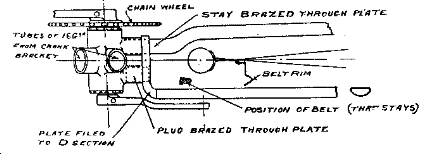 Go to the
Archive index
Go to the
Archive indexIn the early days of motor cycling, most motor cycles were little more than motorised bicycles. The frames used looked just like a pedal cycle frame, although many were strengthened and had a longer wheel base than a normal cycle. Buying a motor cycle would be a very expensive proposition so several would-be riders decided to build their own. Many parts were available: engine castings (in various states of finish), fuel tanks, strengthened "motor" cycle frames. The following piece is a typical example. It was written by a Mr F P Cork who built his own engine to motorise a normal bicycle. It first appeared in The Model Engineer during 1906.
Having purchased a set of castings (with cylinder bored) I decided to finish the engine first, which is 2 1/2in bore and 2 7/8in stroke and rated at 2hp. The cylinder being bored and piston turned, I turned the rings for same. Two rings were fitted and were carefully ground in their slots, and gave every satisfaction in keeping the piston gas tight. The flywheels were then turned, which was rather a heavy job, testing the capabilities of my small 3 1/2in centre lathe. Having finished the engine I started on the tank which was made from tough sheet tin. This tank holds the coil and a 20 amp-hour accumulator and is partitioned off at the front to form a surface carburettor. A thin copper tube feeds the carburettor with petrol from the tank behind the seat. This tank holds enough petrol for about seventy miles' running. I might mention that the carburettor has not given the least trouble and never fails to start even on a frosty morning. The combined throttle and air valve was made from sheet brass and brass tube. The cycle was an ordinary one but after replacing two of the main tubes by tubes of 16 gauge I found it to be of ample strength. Not wishing to use a guide pulley for the belt the frame had to be altered to allow the belt to drive direct on to the belt rim. The sketch shows clearly how this was done. A pair of duplicate forks was fitted, made from iron piping, the ends being flattened out and drilled and clamped to the wheel spindle and crown head, which of course is turned round for the purpose. This machine has run over 1,000 miles, and the pleasure and satisfaction derived from riding has more than repaid the trouble of making it.

A photograph of Mr Cork's machine accompanied the article but was, unfortunately, too dark to reproduce here. The engine was mounted high on the down tube within the frame diamond and the belt drive to the rear wheel comes straight off the end of the crankshaft. A cylindrical tank is mounted Cyc-Auto style behind the saddle and this feeds the second "flat tank", which is really just the carburettor and coil holder. A bicycle-type carbide lamp is fitted at the front. The machine carries the registration number EH 64 so, presumably, Mr Cork came from the Stoke-on-Trent area. Thanks go to Doug Archibald for supplying a copy of the original article.
First published - October 1995